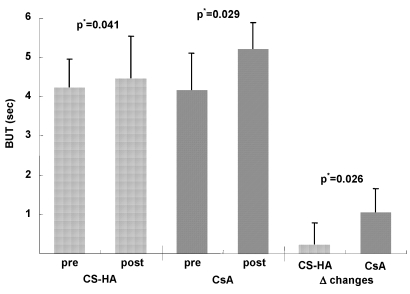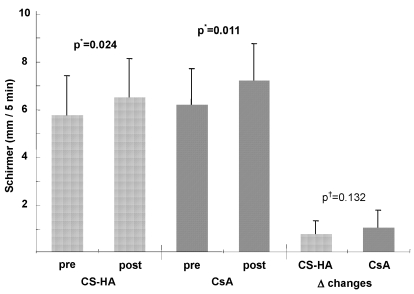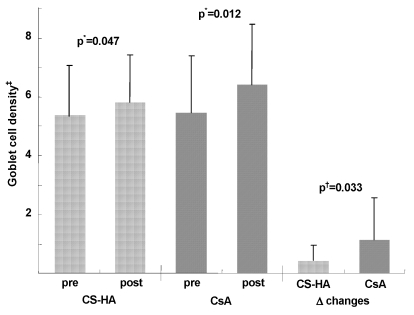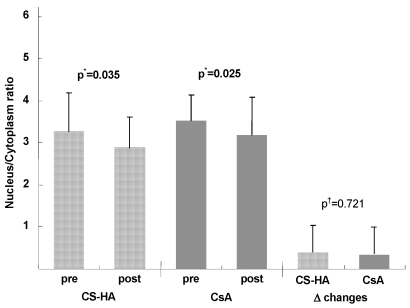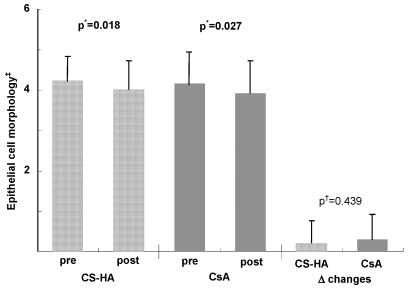Korean J Ophthalmol.
2007 Dec;21(4):189-194. 10.3341/kjo.2007.21.4.189.
Short Term Effects of Topical Cyclosporine and Viscoelastic on the Ocular Surfaces in Patients with Dry Eye
- Affiliations
-
- 1Department of Ophthalmology, Konkuk University Hospital, Seoul, Korea.
- 2Department of Ophthalmology, Seoul National University Hospital, Seoul, Korea. kmk9@snu.ac.kr
- 3Seoul Artificial Eye Center, Seoul National University Hospital Clinical Research Institute, Seoul, Korea.
- 4Department of Ophthalmology, Seoul National University Bundang Hospital, Seongnam, Korea.
- KMID: 754634
- DOI: http://doi.org/10.3341/kjo.2007.21.4.189
Abstract
- PURPOSE: To compare the short term effects of topical 0.05% cyclosporine (CsA) and a mixture of 0.08% chondroitin sulfate and 0.06% sodium hyaluronate (CS-HA) on dry eye ocular surfaces. METHODS: 36 patients with moderate to severe dry eye (5 mm/5 min or less with Schirmer's test or tear break up time (BUT) less than 6 seconds), were treated with topical application of CS-HA on one eye and CsA on the other 4 times a day for 6-8 weeks. BUT, Schirmer's test without anesthesia, and conjunctival impression cytology (CIC; goblet cell density, nucleus to cytoplasmic ratio, and epithelial cell morphology) were evaluated and compared between eyes before and after treatment (repeated measurement of ANOVA). RESULTS: After treatment, BUT and tear wettings were significantly prolonged in each group. Topical CsA treated eyes had greater increase in BUT (p=0.026); there was no significant difference in tear wetting (p=0.132). While the 3 parameters of CIC improved in both groups, goblet cell density was significantly higher in eyes treated with CsA (p=0.033). CONCLUSIONS: While both CS-HA and 0.05% CsA eyedrops improve ocular surfaces, topical CsA may have a better effect on enhancing tear film stability and goblet cell density.
Keyword
MeSH Terms
-
Adjuvants, Immunologic/administration & dosage
Administration, Topical
Cell Count
Chondroitin Sulfates/*administration & dosage
Conjunctiva/drug effects/pathology
Cyclosporine/*administration & dosage
Drug Administration Schedule
Drug Combinations
Drug Therapy, Combination
Dry Eye Syndromes/*drug therapy/metabolism/pathology
Epithelium/drug effects/pathology
Female
Follow-Up Studies
Goblet Cells/drug effects/pathology
Humans
Hyaluronic Acid/*administration & dosage
Immunosuppressive Agents/*administration & dosage
Male
Middle Aged
Ophthalmic Solutions/administration & dosage
Tears/drug effects/metabolism
Time Factors
Treatment Outcome
Figure
Cited by 1 articles
-
Effect of 0.1% Sodium Hyaluronate and 0.05% Cyclosporine on Tear Film Parameters after Cataract Surgery
Won Choi, Kyung-Chul Yoon
J Korean Ophthalmol Soc. 2011;52(7):800-806. doi: 10.3341/jkos.2011.52.7.800.
Reference
-
1. Baudouin C. The pathology of dry eye. Surv Ophthalmol. 2001; 45:S211–S220. PMID: 11587145.
Article2. Lemp MA. Report of the National Eye Institute/Industry workshop on Clinical Trials in Dry Eyes. CLAO J. 1995; 21:221–232. PMID: 8565190.3. Yeh S, Song XJ, Farley W, et al. Apoptosis of ocular surface cells in experimentally induced dry eye. Invest Ophthalmol Vis Sci. 2003; 44:124–129. PMID: 12506064.
Article4. Kunert KS, Tisdale AS, Gipson IK. Goblet cell numbers and epithelial proliferation in the conjunctiva of patients with dry eye syndrome treated with cyclosporine. Arch Ophthalmol. 2002; 120:330–337. PMID: 11879137.
Article5. Turner K, Pflugfelder SC, Ji Z, et al. Interleukin-6 levels in the conjunctival epithelium of patients with dry eye disease treated with cyclosporine ophthalmic emulsion. Cornea. 2000; 19:492–496. PMID: 10928765.
Article6. Pflugfelder SC, Tseng SC, Yoshino K, et al. Correlation of goblet cell density and mucosal epithelial membrane mucin expression with rose bengal staining in patients with ocular irritation. Ophthalmology. 1997; 104:223–235. PMID: 9052626.
Article7. Baudouin C, Brignole F, Becquet F, et al. Flow cytometry in impression cytology specimens: a new method for evaluation of conjunctival inflammation. Invest Ophthalmol Vis Sci. 1997; 8:1458–1464. PMID: 9191610.8. Brignole F, Pisella PJ, Dupas B, et al. Efficacy and safety of 0.18% sodium hyaluronate in patients with moderate dry eye syndrome and superficial keratitis. Graefes Arch Clin Exp Ophthalmol. 2005; 243:531–538. PMID: 15965673.
Article9. Sall K, Stevenson OD, Mundorf TK, Reis BL. Two multicenter, randomized studies of the efficacy and safety of cyclosporine ophthalmic emulsion in moderate to severe dry eye disease. Ophthalmology. 2000; 107:631–639. PMID: 10768324.10. Tatlipinar S, Akpek EK. Topical ciclosporin in the treatment of ocular surface disorders. Br J Ophthalmol. 2005; 89:1363–1367. PMID: 16170133.
Article11. Papa V, Aragona P, Russo S, et al. Comparison of hypotonic and isotonic solutions containing sodium hyaluronate on the symptomatic treatment of dry eye patients. Ophthalmologica. 2001; 215:124–127. PMID: 11244343.
Article12. Nepp J, Schauersberger J, Schild G, et al. The clinical use of viscoelastic artificial tears and sodium chloride in dry-eye syndrome. Biomaterials. 2001; 22:3305–3310. PMID: 11700802.
Article13. Campo GM, Avenoso A, Campo S, et al. Efficacy of treatment with glycosaminoglycans on experimental collagen-induced arthritis in rats. Arthritis Res Ther. 2003; 5:R122–R131. PMID: 12723984.14. Hamano H, Hori M, Hamano T, et al. A new method for measuring tears. CLAO J. 1983; 9:281–289. PMID: 6413088.15. Toda I, Tsubota K. Practical double vital staining for ocular surface evaluation. Cornea. 1993; 12:366–367. PMID: 7687944.
Article16. Saini JS, Rajwanshi A, Dhar S. Clinicopathological correlation of hard contact lens related changes in tarsal conjunctiva by impression cytology. Acta Ophthalmol(Copenh). 1990; 68:65–70. PMID: 2336936.
Article17. Kinoshita S, Kiorpes TC, Friend J, Thoft RA. Goblet cell density in ocular surface disease. A better indicator than tear mucin. Arch Ophthalmol. 1983; 101:1284–1287. PMID: 6882259.18. Barber LD, Pflugfelder SC, Tauber J, Foulks GN. Phase III safety evaluation of cyclosporine 0.1% ophthalmic emulsion administered twice daily to dry eye disease patients for up to 3 years. Ophthalmology. 2005; 112:1790–1794. PMID: 16102833.
Article19. Strong B, Farley W, Stern ME, Pflugfelder SC. Topical cyclosporine inhibits conjunctival epithelial apoptosis in experimental murine keratoconjunctivitis sicca. Cornea. 2005; 24:80–85. PMID: 15604871.
Article20. Moore CP, McHugh JB, Thorne JG, Phillips TE. Effect of cyclosporine on conjunctival mucin in a canine keratoconjunctivitis sicca model. Invest Ophthalmol Vis Sci. 2001; 42:653–659. PMID: 11222523.21. el Tayar N, Mark AE, Vallat P, et al. Solvent-dependent conformation and hydrogen-bonding capacity of cyclosporin A: evidence from partition coefficients and molecular dynamics simulations. J Med Chem. 1993; 36:3757–3764. PMID: 8254605.
Article22. Mithani SD, Bakatselou V, TenHoor CN, Dressman JB. Estimation of the increase in solubility of drugs as a function of bile salt concentration. Pharm Res. 1996; 13:163–167. PMID: 8668668.23. Kuwano M, Ibuki H, Morikawa N, et al. Cyclosporine A formulation affects its ocular distribution in rabbits. Pharm Res. 2002; 19:108–111. PMID: 11837694.24. Limberg MB, McCaa C, Kissling GE, Kaufman HE. Topical application of hyaluronic acid and chondroitin sulfate in the treatment of dry eyes. Am J Ophthalmol. 1987; 103:194–197. PMID: 3101502.
Article25. Shimmura S, Ono M, Shinozaki K, et al. Sodium hyaluronate eyedrops in the treatment of dry eyes. Br J Ophthalmol. 1995; 79:1007–1011. PMID: 8534643.
Article26. Fukuda K, Miyamoto Y, Miyara Y. Hyaluronic acid in tear fluid and its synthesis by corneal epithelial cells. Asia-pacific J Ophthalmo. 1998; 40:62–65.27. Inoue M, Katakami C. The effect of hyaluronic acid on corneal epithelial cell proliferation. Invest Ophthalmol Vis Sci. 1993; 34:2313–2315. PMID: 8505213.28. Nishida T, Nakamura M, Mishima H, Otori T. Hyaluronan stimulates corneal epithelial migration. Exp Eye Res. 1991; 53:753–758. PMID: 1783012.
Article29. Lerner LE, Schawrtz DM, Hwang DG, et al. Hyaluronan and CD44 in the human cornea and limbal conjunctiva. Exp Eye Res. 1998; 67:481–484. PMID: 9820796.
Article30. Entwistle J, Hall CL, Turley EA. HA receptors: signalling to the cytoskeleton. J Cell Biochem. 1996; 61:569–577. PMID: 8806080.31. Rosales C, O'Brien V, Kornberg L, Juliano R. Signal transduction by cell adhesion receptors. Biochem Biophys Acta. 1995; 1242:77–98. PMID: 7542926.
Article32. Miyazaki T, Miyauchi S, Nakamura T, et al. The effect of sodium hyaluronate on the growth of rabbit corneal epithelial cells in vitro. J Ocul Pharmacol Ther. 1996; 12:409–415. PMID: 8951677.33. Nakamura M, Hikida M, Nakano T, et al. Characterization of water retentive properties of hyaluronan. Cornea. 1993; 12:433–436. PMID: 8306665.
Article34. Nelson JD, Farris RL. Sodium hyaluronate and polyvinyl alcohol artificial tear preparations. A comparison in patients with keratoconjunctivitis sicca. Arch Ophthalmol. 1988; 106:484–487. PMID: 2451494.35. Stadler J, Stefanovic-Racic M, Billiar TR, et al. Articular chondrocytes synthesize nitric oxide in response to cytokines and lipopolysaccharide. J Immunol. 1991; 147:3915–3920. PMID: 1658153.36. Solomon A, Dursun D, Liu Z, et al. Pro- and anti-inflammatory forms of interleukin-1 in the tear fluid and conjunctiva of patients with dry-eye disease. Invest Ophthalmol Vis Sci. 2001; 42:2283–2292. PMID: 11527941.
- Full Text Links
- Actions
-
Cited
- CITED
-
- Close
- Share
- Similar articles
-
- Therapeutic Effects of 0.03% Tacrolimus Eye Drops for Chronic Ocular Graft-Versus-Host Disease
- The Effect of Topical Cyclosporine 0.05% on Tear Osmolarity for Dry Eye Syndrome
- Effect of Sodium Hyaluronate and Cyclosporine A on Tear Film in Dry Eye Syndrome
- The Effect of Topical Cyclosporine 0.05% on Dry Eye after Cataract Surgery
- Comparison of the Effects of 0.05% and 0.1% Cyclosporine for Dry Eye Syndrome Patients after Cataract Surgery

